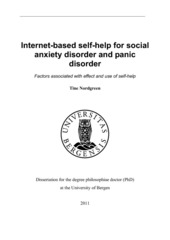| dc.contributor.author | Nordgreen, Tine | |
| dc.date.accessioned | 2011-12-14T09:05:06Z | |
| dc.date.available | 2011-12-14T09:05:06Z | |
| dc.date.issued | 2011-11-08 | eng |
| dc.identifier.isbn | 978-82-308-1872-5 (print version) | eng |
| dc.identifier.uri | https://hdl.handle.net/1956/5287 | |
| dc.description.abstract | Studies have documented the effect of self-help interventions for social anxiety disorder and panic disorder, and self-help interventions have been proposed as a way to improve access to psychological interventions for these disorders. However, heterogeneous treatment effects from self-help have been reported and there is a need to study factors associated with this heterogeneity. The aim of present thesis is to investigate factors associated with the treatment effect and use of self-help with a special emphasis on guided self-help via the Internet for social anxiety disorder and panic disorder. Methods: Paper I was based on an open pre-post design that through a benchmarking strategy examined the transportability of guided self-help via the Internet for panic disorder. Analyses of predictors of outcome were included. Paper II examined predictors of outcome among patients who had received guided self-help via Internet (n = 149) or unguided self-help (n = 96) for social anxiety disorder. Predictors of adherence, diagnosis-free status, and reliable change were examined. Paper III presented a survey of the knowledge and use of self-help among psychologists working in mental health services, and examined factors associated with use of selfhelp. Results: In Paper I, we found that guided self-help via the Internet for panic disorder remained effective in a new setting with therapists inexperienced with self-help. However, there was a trend that treatment effects were less than those reported from the developers’ research clinic. Predictor-analyses indicated that a higher age of patients predicted greater improvement, whereas longer duration of panic disorder predicted less improvement from guided self-help via Internet for panic disorder. In Paper II, severity of social anxiety symptoms before treatment was associated with maintaining a social anxiety diagnose after treatment, whereas comorbid symptoms were not. Moreover, results indicate that patients who perceived unguided self-help for social anxiety as a credible treatment had similar effects to those who had received guided self-help. In Paper III it was found that the majority of professionals working in mental health services had used self-help with their patients. However, self-help was mainly used as an adjunct and not as an alternative to face-to-face contact. Conclusions: With the methodological considerations and limitations in mind, the present thesis gives further support to self-help for social anxiety disorder and panic disorder as an effective treatment across different settings and patient populations. The results also indicate that symptom severity, treatment credibility, and professionals use of self-help as an alternative to face-to-face contact needs to be taken into account in future research and dissemination efforts. | en_US |
| dc.language.iso | eng | eng |
| dc.publisher | The University of Bergen | eng |
| dc.relation.haspart | Paper I: Nordgreen, T., Standal, B., Mannes, H., Haug, T., Sivertsen, B., Carlbring, P., Andersson, G., Heiervang, E., & Havik, O. E. (2010). Guided self-help via internet for panic disorder: Dissemination across countries. Computers in Human Behavior 26(4): 592-596, July 2010. Full text not available in BORA due to publisher restrictions. The article is available at: <a href="http://dx.doi.org/10.1016/j.chb.2009.12.011" target="blank"> http://dx.doi.org/10.1016/j.chb.2009.12.011</a> | eng |
| dc.relation.haspart | Paper II: Nordgreen, T., Havik, O. E., Öst, L-G, Furmark, T., Carlbring, P., & Andersson. G. Outcome predictors in guided and unguided self-help for social anxiety disorder. Behaviour Research and Therapy 50(1): 13-21, January 2012. Full text not available in BORA due to publisher restrictions. The article is available at: <a href="http://dx.doi.org/10.1016/j.brat.2011.10.009" target="blank"> http://dx.doi.org/10.1016/j.brat.2011.10.009</a> | eng |
| dc.relation.haspart | Paper III: Nordgreen, T., & Havik, O.E. (2011). Use of self-help materials for anxiety and depression in mental health services: A national survey of psychologists in Norway. Professional Psychology: Research and Practice 42(2): 185-191, April 2011. Full text not available in BORA due to publisher restrictions. The article is available at: <a href="http://dx.doi.org/10.1037/a0022729" target="blank"> http://dx.doi.org/10.1037/a0022729</a> | eng |
| dc.title | Internet-based self-help for social anxiety disorder and panic disorder. Factors associated with effect and use of self-help | eng |
| dc.type | Doctoral thesis | |
| dc.rights.holder | Copyright the author. All rights reserved | |
| dc.subject.nsi | VDP::Social science: 200::Psychology: 260 | eng |
| dc.subject.nsi | VDP::Medical disciplines: 700::Health sciences: 800::Community medicine, Social medicine: 801 | eng |

